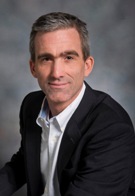
Prof. Edward Knightly
Professor & Department Chair
Electrical and Computer Engineering
Rice University
Scaling Wireless for Next Generation Transformative Applications
We have an insatiable appetite for wireless, wanting ever more bits per second per Hertz per square meter in more places. In this talk, I will describe several transformative applications on the horizon, focusing not merely on making today’s applications faster, but rather asking what impactful applications are not realizable today. Moreover, I will describe the technical challenges to scale wireless technologies to meet these demands. I will begin with a look back on how we got where we are today, drawing on past research advances, standards, and our urban wireless trial in Houston, Technology For All. I will conclude with the road ahead, including open research challenges.
Biography: Edward Knightly is a professor and the department chair of Electrical and Computer Engineering at Rice University in Houston, Texas. He received his Ph.D. and M.S. from the University of California at Berkeley and his B.S. from Auburn University. He is an IEEE Fellow, a Sloan Fellow, and a recipient of the National Science Foundation CAREER Award. He received best paper awards from ACM MobiCom, ACM MobiHoc, IEEE SECON, and the IEEE Workshop on Cognitive Radio Architectures for Broadband. He has chaired ACM MobiHoc, ACM MobiSys, IEEE INFOCOM, and IEEE SECON. He serves as an editor-at-large for IEEE/ACM Transactions on Networking and serves on the IMDEA Networks Scientific Council. Professor Knightly’s research interests are in the areas of mobile and wireless networks with a focus on design, performance evaluation, and at-scale field trials. He leads the Rice Networks Group. The group’s projects include deployment, operation, and management of a large-scale urban wireless network in a Houston under-resourced community. This network, Technology For All (TFA) Wireless, has served over 4,000 users in several square kilometers and employs custom-built programmable and observable access points (see video). The network was the first to provide residential access in frequencies spanning from unused UHF TV bands to legacy Wi-Fi bands (500 MHz to 5 GHz). His group developed the first multi-user beam-forming WLAN system that demonstrates a key performance feature now provided by IEEE 802.11ac. His group also co-developed a clean-slate-design hardware platform for high-performance wireless networks, TAPs and WARP.